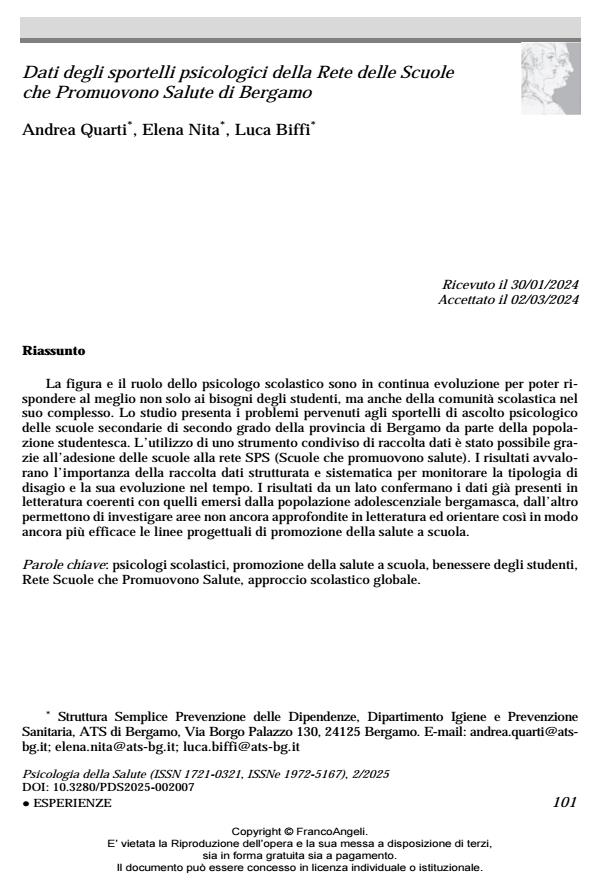Dati degli sportelli psicologici della Rete delle Scuole che Promuovono Salute di Bergamo
Titolo Rivista PSICOLOGIA DELLA SALUTE
Autori/Curatori Andrea Quarti, Elena Nita, Luca Biffi
Anno di pubblicazione 2025 Fascicolo 2025/2
Lingua Italiano Numero pagine 27 P. 101-127 Dimensione file 793 KB
DOI 10.3280/PDS2025-002007
Il DOI è il codice a barre della proprietà intellettuale: per saperne di più
clicca qui
Qui sotto puoi vedere in anteprima la prima pagina di questo articolo.
Se questo articolo ti interessa, lo puoi acquistare (e scaricare in formato pdf) seguendo le facili indicazioni per acquistare il download credit. Acquista Download Credits per scaricare questo Articolo in formato PDF

FrancoAngeli è membro della Publishers International Linking Association, Inc (PILA)associazione indipendente e non profit per facilitare (attraverso i servizi tecnologici implementati da CrossRef.org) l’accesso degli studiosi ai contenuti digitali nelle pubblicazioni professionali e scientifiche
La figura e il ruolo dello psicologo scolastico sono in continua evoluzione per poter rispondere al meglio non solo ai bisogni degli studenti, ma anche della comunità scolastica nel suo complesso. Lo studio presenta i problemi pervenuti agli sportelli di ascolto psicologico delle scuole secondarie di secondo grado della provincia di Bergamo da parte della popolazione studentesca. L’utilizzo di uno strumento condiviso di raccolta dati è stato possibile grazie all’adesione delle scuole alla rete SPS (Scuole che promuovono salute). I risultati avvalorano l’importanza della raccolta dati strutturata e sistematica per monitorare la tipologia di disagio e la sua evoluzione nel tempo. I risultati da un lato confermano i dati già presenti in letteratura coerenti con quelli emersi dalla popolazione adolescenziale bergamasca, dall’altro permettono di investigare aree non ancora approfondite in letteratura ed orientare così in modo ancora più efficace le linee progettuali di promozione della salute a scuola.
Parole chiave:psicologi scolastici, promozione della salute a scuola, benessere degli studenti, Rete Scuole che Promuovono Salute, approccio scolastico globale.
Andrea Quarti, Elena Nita, Luca Biffi, Dati degli sportelli psicologici della Rete delle Scuole che Promuovono Salute di Bergamo in "PSICOLOGIA DELLA SALUTE" 2/2025, pp 101-127, DOI: 10.3280/PDS2025-002007